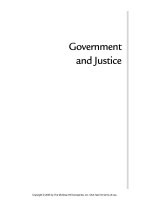Lost for words acre 1
Bạn đang xem bản rút gọn của tài liệu. Xem và tải ngay bản đầy đủ của tài liệu tại đây (47.41 KB, 2 trang )
Academic Reading Passage 1 - Lost for Words
(Source: Cambridge IELTS 4, Cambridge University Press 2005)
In the Native American Navajo nation, which sprawls across four states in the
American south-west, the native language is dying. Most of its speakers are
middle-aged or elderly. Although many students take classes in Navajo, the
schools are run in English. Street signs, supermarket goods and even their own
newspaper are all in English. Not surprisingly, linguists doubt that any native
speakers of Navajo will remain in a hundred years' time.
Navajo is far from alone. Half the world's 6,800 languages are likely to vanish
within two generations - that's one language lost every ten days. Never before
has the planet's linguistic diversity shrunk at such a pace. 'At the moment, we are
heading for about three of four languages dominating the world;' says Mark
Pagel, an evolutionary biologist at the University of Reading. It's a mass
extinction, and whether we will ever rebound from the loss is difficult to know.'
Isolation breeds linguistic diversity; as a result, the world is peppered with
languages spoken by only a few people. Only 250 languages have more than a
million speakers, and at least 3,000 have fewer than 2,500. It is notnecessarily
these small languages that are about to disappear. Navajo is considered
endangered despite having 150,000 speakers. What makes a language
endangered is not just the number of speakers, but how old they are. If it is
spoken by children it is relatively safe. The critically endangered languages are
those that are only spoken by the elderly, according to MichaelKrauss, director of
the Alassk Native Language Center, in Fairbanks.
Why do people reject the language of their parents? It begins with a crisis of
confidence, when a small community finds itself alongside a larger, wealthier
society, says Nicholas Ostler, of Britain's Foundation for Endangered Languages, in
Bath. 'People lose faith in their culture,' he says. 'When the next generation
reaches their teens, they might not want to be induced into the old traditions.'
The change is not always voluntary. Quite often, governments try to kill off a
minority language by banning its use in public or discouraging its use in schools,
all to promote national unity. The former US policy of running Indian reservations
schools in English, for example, effectively put languages such as Navajo on the
danger list. BitSalikoko Mufwene, who chairs the Linguistics department at the
University of Chicago, argues that the deadliest weapon is not government policy
but economic globalisation. 'Native Americans have not lost pride in their
language, but they have had to adapt to socio-economic pressures,' he says.
'They cannot refuse to speak English.' But are languages worth saving? At the
very least, there is a loss of data for the study of languages and their evolution,
which relies on comparisons between languages, both living and dead. When an
unwritten and unrecorded language disappears, it is lost to science.
Language is also intimately bound up with culture, so it may be difficult to
preserve one without the other. 'If a person shifts from Navajo to English, they
lose something,'Mufwene says. 'Moreover, the loss of diversity may also deprive
us of different ways of looking at the world,' says Pagel. There is mounting
evidence that learning a language produces physiological changes in the brain.
'Your brain and mine are different from the brain of someone who speaks French,
for instance,' Pagel says, and this could affect our thoughts and perceptions.' The
patterns and connections we make among various concepts may be structured by
the linguistic habits of our community.'
So despite linguists' best efforts, many languages will disappear over the next
century. But a growing interest in cultural identity may prevent the direst
predictions from coming true. 'The key to fostering diversity is for people to learn
theirancestral tongue, as well as the dominant language,' says Doug Whalen,
founder and president of the Endangered Language Fund in New Haven,
Connecticut. 'Most of these languages will not survive without a large degree of
bilingualism,' he says. In NewZealand, classes for children have slowed the
erosion of Maori and rekindled interest in the language. A similar approach in
Hawaii has produced about 8,000 new speakers of Polynesian languages in the
past few years. In California, 'apprentice' programmes have provided life support
to several indigenous languages. Volunteer 'apprentices' pair up with one of the
last living speakers of a Native American tongue to learn a traditional skill such as
basket weaving, with instruction exclusively in the endangered language. After
about 300 hours of training they are generally sufficiently fluent to transmit the
language to the next generation. But Mufwene says that preventing a language
dying out is not the same as giving it new life by using it everyday. 'Preserving a
language is more like preserving fruits in a jar,' he says.
However, preservation can bring a language back from the dead. There are
examples of languages that have survived in written form and then been revived
by later generations. But a written form is essential for this, so the mere
possibility of revival has led many speakers of endangered languages to develop
systems of writing where none exited before.









